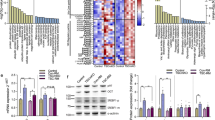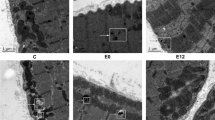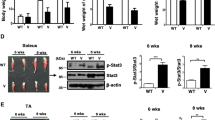Abstract
Our aim is to gain insight into the mechanisms underlying the anti-atrophic effects of leucine, namely, the way that this amino acid can restrain the up-regulation of MuRF1 and Mafbx/Atrogin-1 in muscle atrophy. Male rats received dietary leucine supplementation for 1–3 days, during which time their hind limbs were immobilized. Our results showed that leucine inhibited Forkhead Box O3 (FoxO3a) translocation to cell nuclei. In addition, leucine was able to reverse the expected reduction of FoXO3a ubiquitination caused by immobilization. Unexpectedly, leucine promoted these effects independently of the Class I PI3K/Akt pathway. Vacuolar protein sorting 34 (VPS34; a Class III PI3K) was strongly localized in nuclei after immobilization and leucine supplementation was able to prevent this effect. In experiments on cultured primary myotubes, dexamethasone led to the localization of VPS34 in the nucleus. In addition, the pharmacological inhibition of VPS34 blocked VPS34 nuclear localization and impaired the protective effect of leucine upon myotube trophicity. Finally, the pharmacological inhibition of VPS34 in primary myotubes prevented the protective effects of leucine upon MuRF1 and Mafbx/Atrogin-1 gene expression. Autophagy-related target genes were not responsive to leucine. Thus, we demonstrate that the anti-atrophic effect of leucine is dependent upon FoxO3a suppression and VPS34 activity.






Similar content being viewed by others
Abbreviations
- 3MA:
-
3-Methylaldenine
- BNIP3:
-
BCL2/adenovirus E1B 19 kDa protein-interacting protein 3
- FoxO3a:
-
Forkhead BoxO3
- VPS34:
-
Vacuolar protein sorting 34
- Im:
-
Immobilization procedure
- Leu:
-
Leucine-supplemented animal
- Dexa:
-
Dexamethasone-treated myotubes
- DAPI:
-
4′,6-Diamidino-2-phenylindole
- MuRF1:
-
Muscle-specific ring finger protein 1
- PI3K:
-
Phosphatidylinositol-3-kinase
- mTOR:
-
Mammalian target of rapamycin
- Poly-UB:
-
Poly-ubiquitin
References
Aoki MS, Lima WP, Miyabara EH, Gouveia CH, Moriscot AS (2004) Deleterious effects of immobilization upon rat skeletal muscle: role of creatine supplementation. Clin Nutr 23:1176–1183
Baptista IL, Leal ML, Artioli GG, Aoki MS, Fiamoncini J, Turri AO, Curi R, Miyabara EH, Moriscot AS (2010) Leucine attenuates skeletal muscle wasting via inhibition of ubiquitin ligases. Muscle Nerve 41:800–808
Baptista IL, Silva WJ, Artioli GG, Guilherme JP, Leal ML, Aoki MS, Miyabara EH, Moriscot AS (2013) Leucine and HMB differentially modulate proteasome system in skeletal muscle under different sarcopenic conditions. PLoS One 8:e76752
Bertaggia E, Coletto L, Sandri M (2012) Posttranslational modifications control FoxO3 activity during denervation. Am J Physiol Cell Physiol 302:C587–C596
Bodine SC, Latres E, Baumhueter S, Lai VK, Nunez L, Clarke BA, Poueymirou WT, Panaro FJ, Na E, Dharmarajan K, Pan ZQ, Valenzuela DM, DeChiara TM, Stitt TN, Yancopoulos GD, Glass DJ (2001) Identification of ubiquitin ligases required for skeletal muscle atrophy. Science 294:1704–1708
Daitoku H, Fukamizu A (2007) FOXO transcription factors in the regulatory networks of longevity. J Biochem 141:769–774
Dalton RE, Tripathi RS, Abel EE, Kothari DS, Firstenberg MS, Stawicki SP, Papadimos TJ (2012) Polyneuropathy and myopathy in the elderly. HSR Proc Intensive Care Cardiovasc Anesth 4:15–19
Desgeorges MM, Freyssenet D, Chanon S, Castells J, Pugniere P, Bechet D, Peinnequin A, Devillard X, Defour A (2014) Post-transcriptional regulation of autophagy in C2C12 myotubes following starvation and nutrient restoration. Int J Biochem Cell Biol 54:208–216
Efeyan A, Zoncu R, Sabatini DM (2012) Amino acids and mTORC1: from lysosomes to disease. Trends Mol Med 18:524–533
English KL, Mettler JA, Ellison JB, Mamerow MM, Arentson-Lantz E, Pattarini JM, Ploutz-Snyder R, Sheffield-Moore M, Paddon-Jones D (2016) Leucine partially protects muscle mass and function during bed rest in middle-aged adults. Am J Clin Nutr 103:465–473
Enoki Y, Watanabe H, Arake R, Sugimoto R, Imafuku T, Tominaga Y, Ishima Y, Kotani S, Nakajima M, Tanaka M, Matsushita K, Fukagawa M, Otagiri M, Maruyama T (2016) Indoxyl sulfate potentiates skeletal muscle atrophy by inducing the oxidative stress-mediated expression of myostatin and atrogin-1. Sci Rep 6:32084
Girón MD, Vílchez JD, Shreeram S, Salto R, Manzano M, Cabrera E, Campos N, Edens NK, Rueda R, López-Pedrosa JM (2015) β-Hydroxy-β-methylbutyrate (HMB) normalizes dexamethasone-induced autophagy-lysosomal pathway in skeletal muscle. PLoS One 10:e0117520
Glass DJ (2003) Molecular mechanisms modulating muscle mass. Trends Mol Med 9:344–350
Gomes MD, Lecker SH, Jagoe RT, Navon A, Goldberg AL (2001) Atrogin-1, a muscle-specific F-box protein highly expressed during muscle atrophy. Proc Natl Acad Sci U S A 98:14440–14445
Gulati P, Thomas G (2007) Nutrient sensing in the mTOR/S6K1 signalling pathway. Biochem Soc Trans 35:236–238
Han JM, Jeong SJ, Park MC, Kim G, Kwon NH, Kim HK, Ha SH, Ryu SH, Kim S (2012) Leucyl-tRNA synthetase is an intracellular leucine sensor for the mTORC1-signaling pathway. Cell 149:410–424
Hasselgren PO, Alamdari N, Aversa Z, Gonnella P, Smith IJ, Tizio S (2010) Corticosteroids and muscle wasting: role of transcription factors, nuclear cofactors, and hyperacetylation. Curr Opin Clin Nutr Metab Care 13:423–428
Jaitovich A, Angulo M, Lecuona E, Dada LA, Welch LC, Cheng Y, Gusarova G, Ceco E, Liu C, Shigemura M, Barreiro E, Patterson C, Nader GA, Sznajder JI (2015) High CO2 levels cause skeletal muscle atrophy via AMP-activated kinase (AMPK), FoxO3a protein, and muscle-specific ring finger protein 1 (MuRF1). J Biol Chem 290:9183–9194
Jewell JL, Russell RC, Guan KL (2013) Amino acid signalling upstream of mTOR. Nat Rev Mol Cell Biol 14:133–139
Judge SM, Wu C-L, Beharry AW, Roberts BM, Ferreira LF, Kandarian SC, Judge AR (2014) Genome-wide identification of FoxO-dependent gene networks in skeletal muscle during C26 cancer cachexia. BMC Cancer 14:1–17
Kawai N, Hirasaka K, Maeda T, Haruna M, Shiota C, Ochi A, Abe T, Kohno S, Ohno A, Teshima-Kondo S, Mori H, Tanaka E, Nikawa T (2015) Prevention of skeletal muscle atrophy in vitro using anti-ubiquitination oligopeptide carried by atelocollagen. Biochim Biophys Acta 1853:873–880
Kimball SR, Jefferson LS (2001) Regulation of protein synthesis by branched-chain amino acids. Curr Opin Clin Nutr Metab Care 4:39–43
Kimball SR, Jefferson LS (2006) Signaling pathways and molecular mechanisms through which branched-chain amino acids mediate translational control of protein synthesis. J Nutr 136:227S–231S
Koopman R, Loon LJ van (2009) Aging, exercise, and muscle protein metabolism. J Appl Physiol 1985 106:2040–2048
Lecker SH, Jagoe RT, Gilbert A, Gomes M, Baracos V, Bailey J, Price SR, Mitch WE, Goldberg AL (2004) Multiple types of skeletal muscle atrophy involve a common program of changes in gene expression. FASEB J 18:39–51
Lynch GS, Schertzer JD, Ryall JG (2007) Therapeutic approaches for muscle wasting disorders. Pharmacol Ther 113:461–487
MacKenzie MG, Hamilton DL, Murray JT, Taylor PM, Baar K (2009) mVps34 is activated following high-resistance contractions. J Physiol (Lond) 587:253–260
Mammucari C, Milan G, Romanello V, Masiero E, Rudolf R, Del Piccolo P, Burden SJ, Di Lisi R, Sandri C, Zhao J, Goldberg AL, Schiaffino S, Sandri M (2007) FoxO3 controls autophagy in skeletal muscle in vivo. Cell Metab 6:458–471
Masiero E, Sandri M (2010) Autophagy inhibition induces atrophy and myopathy in adult skeletal muscles. Autophagy 6:307–309
Masiero E, Agatea L, Mammucari C, Blaauw B, Loro E, Komatsu M, Metzger D, Reggiani C, Schiaffino S, Sandri M (2009) Autophagy is required to maintain muscle mass. Cell Metab 10:507–515
Medina R, Wing SS, Goldberg AL (1995) Increase in levels of polyubiquitin and proteasome mRNA in skeletal muscle during starvation and denervation atrophy. Biochem J 307:631–637
Menconi MJ, Arany ZP, Alamdari N, Aversa Z, Gonnella P, O’Neal P, Smith IJ, Tizio S, Hasselgren P-O (2010) Sepsis and glucocorticoids downregulate the expression of the nuclear cofactor PGC-1β in skeletal muscle. Am J Physiol Endocrinol Metab 299:E533–E543
Nobukuni T, Joaquin M, Roccio M, Dann SG, Kim SY, Gulati P, Byfield MP, Backer JM, Natt F, Bos JL, Zwartkruis FJ, Thomas G (2005) Amino acids mediate mTOR/raptor signaling through activation of class 3 phosphatidylinositol 3OH-kinase. Proc Natl Acad Sci U S A 102:14238–14243
Plas DR, Thompson CB (2003) Akt activation promotes degradation of tuberin and FOXO3a via the proteasome. J Biol Chem 278:12361–12366
Powers SK, Wiggs MP, Duarte JA, Zergeroglu AM, Demirel HA (2012) Mitochondrial signaling contributes to disuse muscle atrophy. Am J Physiol Endocrinol Metab 303:E31–E39
Reed SA, Sandesara PB, Senf SM, Judge AR (2012) Inhibition of FoxO transcriptional activity prevents muscle fiber atrophy during cachexia and induces hypertrophy. FASEB J 26:987–1000
Schmitt TL, Martignoni ME, Bachmann J, Fechtner K, Friess H, Kinscherf R, Hildebrandt W (2007) Activity of the Akt-dependent anabolic and catabolic pathways in muscle and liver samples in cancer-related cachexia. J Mol Med 85:647–654
Senf SM, Sandesara PB, Reed SA, Judge AR (2011) p300 acetyltransferase activity differentially regulates the localization and activity of the FOXO homologues in skeletal muscle. Am J Physiol Cell Physiol 300:C1490–C1501
Sharples AP, Hughes DC, Deane CS, Saini A, Selman C, Stewart CE (2015) Longevity and skeletal muscle mass: the role of IGF signalling, the sirtuins, dietary restriction and protein intake. Aging Cell 14:511–523
Sugawara T, Ito Y, Nishizawa N, Nagasawa T (2007) Supplementation with dietary leucine to a protein-deficient diet suppresses myofibrillar protein degradation in rats. J Nutr Sci Vitaminol (Tokyo) 53:552–555
Suryawan A, Davis TA (2011) Regulation of protein synthesis by amino acids in muscle of neonates. Front Biosci (Landmark Ed) 16:1445–1460
Tiao G, Fagan JM, Samuels N, James JH, Hudson K, Lieberman M, Fischer JE, Hasselgren PO (1994) Sepsis stimulates nonlysosomal, energy-dependent proteolysis and increases ubiquitin mRNA levels in rat skeletal muscle. J Clin Invest 94:2255–2264
Vanitallie TB (2003) Frailty in the elderly: contributions of sarcopenia and visceral protein depletion. Metabolism 52:22–26
Wilkinson DJ, Hossain T, Hill DS, Phillips BE, Crossland H, Williams J, Loughna P, Churchward-Venne TA, Breen L, Phillips SM, Etheridge T, Rathmacher JA, Smith K, Szewczyk NJ, Atherton PJ (2013) Effects of leucine and its metabolite β-hydroxy-β-methylbutyrate on human skeletal muscle protein metabolism. J Physiol (Lond) 591:2911–2923
Wing SS, Haas AL, Goldberg AL (1995) Increase in ubiquitin-protein conjugates concomitant with the increase in proteolysis in rat skeletal muscle during starvation and atrophy denervation. Biochem J 307:639–645
Wu Y-T, Tan H-L, Shui G, Bauvy C, Huang Q, Wenk MR, Ong C-N, Codogno P, Shen H-M (2010) Dual role of 3-methyladenine in modulation of autophagy via different temporal patterns of inhibition on class I and III phosphoinositide 3-kinase. J Biol Chem 285:10850–10861
Yan Y, Flinn RJ, Wu H, Schnur RS, Backer JM (2009) hVps15, but not Ca2+/CaM, is required for the activity and regulation of hVps34 in mammalian cells. Biochem J 417:747–755
Yoon MS (2015) Vps34 and PLD1 take center stage in nutrient signaling: their dual roles in regulating autophagy. Cell Commun Signal 13:44
Yoon MS, Chen J (2013) Distinct amino acid-sensing mTOR pathways regulate skeletal myogenesis. Mol Biol Cell 24:3754–3763
Yuan HX, Russell RC, Guan KL (2013) Regulation of PIK3C3/VPS34 complexes by MTOR in nutrient stress-induced autophagy. Autophagy 9:1983–1995
Zhao J, Brault JJ, Schild A, Cao P, Sandri M, Schiaffino S, Lecker SH, Goldberg AL (2007) FoxO3 coordinately activates protein degradation by the autophagic/lysosomal and proteasomal pathways in atrophying muscle cells. Cell Metab 6:472–483
Zhao T, Qi Y, Li Y, Xu K (2012) PI3 kinase regulation of neural regeneration and muscle hypertrophy after spinal cord injury. Mol Biol Rep 39:3541–3547
Acknowledgments
We thank Fundação de Amparo à Pesquisa do Estado de São Paulo (Research Grant no. 2015/04090-0), Conselho Nacional de Desenvolvimento Científico e Tecnológico (Fellowship/grant no. 306915/2014-6) the Research Executive Agency (FP7 network Sarcosi no. 291834) and the Leducq Fondation.
Author information
Authors and Affiliations
Corresponding author
Electronic supplementary material
Below is the link to the electronic supplementary material.
ESM 1
a–i Immunodetection of FoxO1 with identification of nuclei (DAPI, blue) in cross sections from immobilized soleus. The animals had one leg immobilized for 1 day (d–f) and were supplemented with leucine (g–i). Bar (in a) 100 μm. j Real-time polymerase chain reaction analysis of MuRF1 in soleus muscle of animals supplemented with leucine (Leu), hind limb immobilized (Im) for 3 days, and concomitantly immobilized and supplemented with leucine (Im+Leu) for 3 days. k Soleus mass of animals supplemented with leucine (Leu), hind limb immobilized (Imob) for 7 days, and concomitantly immobilized and supplemented with leucine (Im+Leu) for 7 days. Bars indicate mean plus standard deviation. Letters above indicate P < 0.05 vs Control (a), P < 0.05 vs Leu group (b), P < 0.05 vs Im or Imob group (c). n = 5. (DOC 89 kb)
Rights and permissions
About this article
Cite this article
Baptista, I.L., Silvestre, J.G., Silva, W.J. et al. FoxO3a suppression and VPS34 activity are essential to anti-atrophic effects of leucine in skeletal muscle. Cell Tissue Res 369, 381–394 (2017). https://doi.org/10.1007/s00441-017-2614-z
Received:
Accepted:
Published:
Issue Date:
DOI: https://doi.org/10.1007/s00441-017-2614-z




